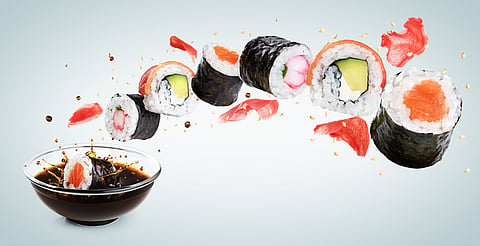
- Destinations
- Experiences
- Stay
- What's new
- Editor’s Picks
- Responsible Tourism
- CampaignsCampaigns
- Subscribe

Relishing on some mouthwatering Sushi is always a flavourful and pleasurable experience, whether you want the classic American sushi rolls or the more authentic varieties like sashimi and nigiri. However, if you haven't eaten enough sushi, you may be confused about what you're meant to do when eating the iconic Japanese dish and nervous about how to eat it properly.
The Beginning
Sushi is the first thing that comes to mind when you think about Japanese food. It comprises cooked vinegared rice (sushi-meshi) and other ingredients (neta), including seafood, vegetables, eggs, fruit, or a mix. Sushi may be traced back millennia to the rice fields of Asia, specifically China. This may come as a surprise to you, considering most people believe sushi was invented in Japan. This, however, is not the case. While Japan is undoubtedly the world's sushi centre and is responsible for introducing the meal to visitors, sushi may be traced back to a Chinese delicacy called narezushi.
As a matter of fact, the history of sushi is a fascinating story about the evolution of a simple meal in the 2nd century A.D.
Sushi originated as a method of preserving food. And interestingly, when eating the fish, the rice was usually dumped. It was only used to wrap and store the fish. In the eighth century, the dish migrated from China to Japan. The term "sushi" originally appeared in the Yoro Code, established in 718.
The dish gradually evolved throughout the centuries that followed. The Japanese started eating three meals a day, boiling their rice and using rice vinegar to make the rice ferment quickly. The scent of the preserved fish remained, but a speedier fermentation process helped in reducing the time it required to prepare the Japanese sushi meal.
The Evolution Of Sushi
In the early 19th century, a man named Hanaya Yohei envisioned a significant change in the manufacture and presentation of his sushi. He no longer wrapped the fish in rice and instead placed a fresh piece of fish on top of an oblong-shaped part of seasoned rice. This form is today known as "nigiri sushi" (finger sushi) or "edomae sushi" (after Edo, the name of Tokyo at the time). This style of serving sushi rapidly spread throughout Japan, aided by the Great Kanto earthquake in 1923, as many people lost their homes and businesses and moved from Tokyo to various other parts of the country.
Following WWII, the sushi stalls were closed and relocated indoors to more hygienic conditions. Later, more formal seating was added (the earliest prototypes were simply an indoor version of the sushi stalls), and sushi evolved from a "quick food" experience to a complete dining experience. It spread worldwide, and with the promotion of seafood, this unique method of eating fish was swiftly embraced by western cultures constantly looking for something new, especially something as sophisticated and special as sushi.
Modern Sushi
Sushi, the exquisite dining experience once exclusive to Japan, has advanced beyond traditional techniques. New sushi types have emerged due to Western influences, including California rolls and the many intricate "fusion" dishes served at luxury sushi restaurants. And this dish's history is far from over&mdashit is continually being written.
Types Of Sushi
Nigiri rice balls topped with tuna, shrimp, eel, or fried eggs.
Gunkan Sushi rice and dried seaweed cups filled with seafood may include sea urchins and fish eggs.
Norimaki Sushi rice and toppings are wrapped in dried seaweed sheets (nori). Seafood, eggs, veggies, and other ingredients can be used as fillings.
Temaki hand-rolled nori cones filled with sushi rice, fish, and other vegetables.
Inari Sushi rice wrapped in deep-fried tofu packets.
Chirashi Sushi rice is topped with seafood, mushrooms, and vegetables.
